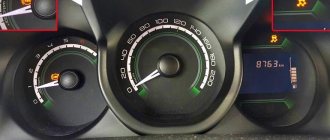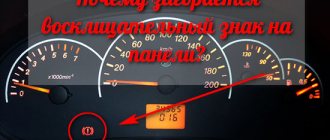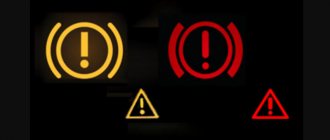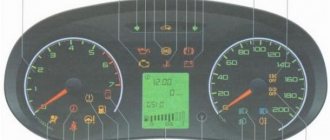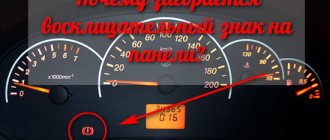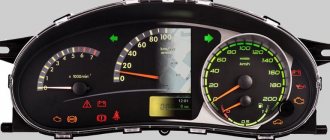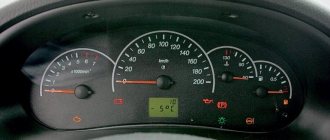The instrument panel of the Lada Priora contains numerous elements, without which the car simply cannot function normally, show the serviceability of systems, or warn the driver about breakdowns. It is on the panel that you will find:
- car speedometer and tachometer;
- on-board computer indicator;
- numerous light bulbs.
If one of the lights lights up, then this, of course, indicates a breakdown. With the help of a certain icon, it is quite easy for experienced drivers to determine which automotive component needs repair. In the meantime, it is best for inexperienced car owners to familiarize themselves with each element located on the instrument panel in order to promptly eliminate the cause of the breakdown with their own hands. The information in this article and advice from professionals will help car owners familiarize themselves with the dashboard and understand why a particular light on the panel may light up.
How the icons on the dashboard work
To understand what is happening with the car, first of all, the car owner must understand how the icons on the dashboard (pictograms) work and how they signal malfunctions.
Different vehicles may display many different icons on the dashboard to inform the driver about the operation of a particular system. These are the braking system, anti-lock braking system and stability control system, battery charging system, airbag system, tire pressure monitoring system and auxiliary systems such as cruise control.
Each time you start the engine, all the icons on the instrument panel should light up and go out after a second or two, indicating that the bulbs on the icons have not burned out, the icons themselves are working, and the systems that are in working order have not burned out or are working uncontrolled. If all the lights go out when you start the engine, but one or two remain on, you need to check the system they control.
Sometimes icons may appear on the instrument cluster while driving. Most often, this means that the car requires urgent military intervention, and the driver must immediately stop and turn off the engine.
Also, on some car models, the “exclamation mark” icon may not always be on, but periodically turns on and off—“blinking.”
For what other reasons might the lights on the dashboard start to light up?
According to experts, faults in electronics can also cause indexing. Icons may appear involuntarily on the dashboard due to the following breakdowns:
- if the contacts succumb to the oxidation process;
- if the terminals change their location;
- if breakdowns occur in the on-board car computer.
Taking into account the advice of experts, and in order not to harm one of the car systems, you need to check the functionality of electronic components. To do this, you will need to diagnose the electronic part, which is done quite easily - remove the dashboard and check the location of the terminals in the so-called sockets. And if the brake fluid level indicator lights up, then first of all the fluid level in a special tank is checked, and only after that new brake fluid is filled in to the recommended level.
Understanding why the light on the dashboard lights up and finding out what kind of breakdown this or that sign indicates is quite simple if you familiarize yourself with each element located on the instrument panel.
Messages: 620 Registered: June 29, 2011, 00:00 Experience: 04/21/2011 Car: Kia Seed
Dashboard indicator symbols
When starting up, almost all the order icons light up: this checks the operation of the light bulbs. Some drivers believe that these are messages regarding malfunctions of any Lada Priora system.
| not on the diagram | Indicator symbols |
| 1 | Speedometer. The device measures the crankshaft speed (revolutions per minute). If the arrow exceeds the red value, it means that the Lada Priora engine is operating dangerously; |
| 2 | Brake force distributor indicator. Report malfunctions in the operation of this unit; |
| 3 | Charger. If the light comes on while the engine is running, the battery is discharged; |
| 4 | Left Turn Signal. The icon flashes when there is an alarm or the left indicator is on; |
| 5 | Speedometer. The device signals the speed at which your Lada Priora is currently moving; |
| 6 | Emergency lubricant pressure in the engine. If the sign is on when the control unit is operating, the pressure in the system is low, it is strictly not recommended to start the engine in this state; |
| 7 | Right turn signal (see No. 4); |
| eight | Handbrake indicator. Lights up yellow if Lada Priora is on the “handbrake”; |
| nine | Antifreeze temperature in the cooling system. The engine operating temperature starts from 90 ° and above to the red mark. In case of overheating, turn off the engine; |
| 10 | Fuel level in the tank. If the fuel level approaches the minimum level, the fuel pump may fail; |
| eleven | Reserve gasoline level. The light comes on when there are less than 10 liters left; |
| 12 | Button for resetting the daily mileage and switching between display modes; |
| 13 | Anxiety. If you have activated the emergency range, the warning light will flash along with the turn signal arrows; |
| 14 | Electrical booster malfunctions. If defects are detected in the EUR, the lamp will light up while the engine is running; |
| 15 | Designation of main beams. An active indicator indicates that you have switched to distant; |
| 16 | Outdoor Lighting. The system warns the driver about the operation of the headlights or low beams; |
| 17 | Airbag malfunctions. If the warning light comes on after starting, it is very likely that the airbags will not deploy in the event of a collision; |
| 18 | Immobilizer. One beep and one flash indicate a malfunction of the immobilizer system; |
| 19 | Computer screen. Here you can view information from the bookmaker, as well as find out the total and daily mileage; |
| winds | Identification of unfastened seat belts. The buzzer signals a violation for 90 seconds; |
| 21 years old | The brake system is in poor condition. Very often these are worn pads or insufficient fluid in the system; |
| 22 | Disabling a specific airbag; |
| 23 | ASB malfunction indicator, the brake system is operating normally; |
| 24 | Check the engine: the engine is faulty, diagnosis and subsequent repairs are urgent. |
Electronic instrument cluster flash x4 for Lada Priora, Kalina, VAZ 2110-2112
Route service including:
- Statistics for the trip, current and previous day;
- Active warning system - on-board network, injection controller, low fuel level, critical engine temperature, parking brake, exceeding the set speed, possibility of ice; maintenance reminder system (oil change, filters, spark plugs, belts).
- A diagnostic service that allows, if there are errors, to obtain their decoding in expanded text form.
- View telemetry data.
- The software supports January 5.1/7.2, BOSCH M1.5.4, MP7.0 Euro II/III, MP7.9.7 Euro II/III, M73, M74.
- A visual service, when the user can choose what parameters he wants to see on the screen, plus the choice of display fonts, adjusting the brightness of groups of indicators.
- Autolight. The “Autolight” controller, produced by “Elekomm” as a separate product, is simply a function in the FLASH X4 instrument cluster!
- The software update system provides the ability to download new versions of the program without removing (dismounting) FLASH X4.
Purpose:
- Functional purpose: a control and diagnostic device for displaying vehicle operating parameters, diagnostics and service support.
- The following functions are implemented in the FLASH X4 CEP:
CEP "FLASH X4" processes information coming from:
Parameters measured by the CEP computer “FLASH X4”:
- Vehicle mileage (based on speed sensor). Sensor parameters: 6000 pulses. for 1 km. mileage;
- Fuel consumption per hour or per 100 km. (based on fuel consumption sensor). Signal parameters: 16000 pulses. for 1l. fuel;
- Time with discreteness of 1 sec. Accuracy is no worse than /- 2 sec., per day;
- Voltage in the vehicle's on-board network with an accuracy of 0.1V unit of the least significant digit in the range of 0-24 V;
- External temperature using external temperature sensor 2115-382810 VDO (TU 4573-003-43820854-98);
- Remaining fuel in the tank (using the standard fuel sensor).
Specifications:
- Operating supply voltage range: from 8 to 24 V.
- Current consumption in operating mode: from 0.25 to 2 A.
- Current consumption in parking mode: from 0 to 10 mA.
- Ambient temperature during storage: from -30 to 85 degrees. WITH.
- Ambient temperature during operation: from -20 to 70 degrees. WITH.
- Relative air humidity up to 90% at a temperature of 40°C.
- Supported interfaces: K-Line in accordance with ISO9141 and ISO14210J.
- Overall dimensions: no more than 130x130x360 mm.
- Weight (without accessories): no more than 1500 g.
Based on continuously received information, the CEP displays a large number of instantaneous and statistical parameters of vehicle movement in a user-friendly form.
The instrument cluster computer notifies the driver about malfunctions of the injection system and electrical equipment of the vehicle (on-board voltage exceeding permissible limits, errors in the engine management system controller, deviation from the required limits of the parameters of the input and output signals of the controller), and offers the user a map to find the fault that has arisen;
Based on data on the vehicle’s mileage and the calendar stored in the memory, it reminds you of the need for regular vehicle maintenance and issuing a list of mandatory work; allows the user to set parameters for various alerts depending on time, date, fuel remaining, current speed or vehicle mileage. Using a computer, you can view and adjust the parameters of the electronic engine control unit (ECU), as well as control the operation of individual components and mechanisms of the vehicle.
Controls: The only external control of the FLASH X4 CEC is the encoder. By turning the knob (without pressing), you can adjust the brightness of the backlight of the instrument cluster, as well as the heater and other devices, the brightness of which was previously adjusted using a standard regulator. Turning the encoder and pressing alternately changes the available screens. Double-clicking (with a short interval) on the encoder enters the user menu from the main menu. When entering this mode, the backlight brightness cannot be adjusted until you exit the menu.
Technical solutions:
A special feature of the FLASH X4 CEP, in contrast to standard devices for similar purposes, is its high functionality. The following is a description of specific technical solutions that the buyer should be aware of, showing the level of development.
- The coolant temperature indicator consists of 8 LEDs. The first 6 turn on with a green glow. The 7th LED is red. Turning on the 8th (also red) switches the 7th and 8th LEDs into flashing mode with a simultaneous sound signal.
- The fuel level indicator also consists of 8 LEDs. When the tank is full, they all have a green glow. If the level drop has reached the 2nd LED, the 1st and 2nd lights up red. If the level drop reaches the 1st LED, both (1st and 2nd) begin to blink, attracting the driver’s attention and reminding them of the need for urgent refueling.
- In addition to the external one, on the front panel of the FLASH X4 CEC, there is a window for a built-in photosensor. When the light level changes, based on the sensor signal, the level of illumination of the revolutions, speed, coolant temperature and fuel level indicators changes.
- The overspeed alarm built into the “FLASH X4” CEP operates as follows: In the “SETTINGS” menu, 2 speed alarm thresholds are set. When the speed reaches the first threshold, the “FLASH X4” indicator begins to flash, urging you to slow down. When the 2nd threshold is reached, the indicator switches to continuous lighting mode. If desired, the speed warning system can be disabled through the same menu section.
- The 7-segment tachometer indicator shows the value in the “0.75” format up to 1000 rpm, and when exceeded, turns off the least significant digit.
- The “DEMO” mode can be turned on either through the menu using the encoder, or by supplying 12V to both inputs of the direction indicators. In this case, the mode is switched on after 10 seconds, with the obligatory supply of power to the 12V-Battery and 12V-Ignition switch contacts.
- The user has the opportunity to turn on the backlight of the instrument cluster without turning on the side light switch. This can be done through the “SETTINGS” menu by checking the required line.
New Lada: Lada Priora - characteristics, configurations, photos, videos, review
Enabling EPC. Main menu: When you turn on the ignition, a splash screen appears on the display with a picture of the car, software version number and date. After a short pause, you switch to the main menu.
In addition to the LED scales, the coolant temperature and remaining fuel are shown in numbers. Low coolant temperatures are shown as "?". Data that is outside the tolerances is also shown, which in many cases means a sensor break. The clock shows the current time in 24:00 format; Fuel consumption is shown when parked in liters per hour, and at speed > 0, in liters per 100 km. mileage;
Battery voltage – in volts and tenths of a volt; Daily mileage – in kilometers and hundreds of meters after the separator; Total mileage – in kilometers. Storage of information about total mileage is non-volatile.
Double-clicking (with a short interval) on the encoder transitions from the main menu to the user menu. If all the lines of the selected menu do not fit on the screen, a down arrow is displayed at the bottom, indicating that by rotating the encoder you can move through the menu below, calling up all possible functions. You can enter the “below” menu level by pressing the encoder once. Exit the submenu by moving the “highlighted” line to “exit menu” and pressing the encoder once. If you do not touch the encoder for 30 seconds, or turn off and then turn on the ignition, an automatic transition to the main menu will occur. To change digital parameters, you need to stand on the selected line and press the encoder once. An icon <...-> will appear in the upper right part of the screen, indicating the possibility of data collection.
What does the exclamation mark mean?
In the vast majority of cars, an exclamation point icon on the dashboard indicates a problem with the car's braking system. Often lights up along with an icon indicating the operation of the ABS system and vehicle stabilization system (if equipped). The appearance of these icons on the driver's dashboard indicates a possible malfunction of the brake system and unreliability of the brakes.
A malfunction in the car’s braking system is included in the list of malfunctions in which the operation of the car is prohibited by the “Road Rules”. In addition, the driver himself must be clear that driving with faulty brakes can lead to the most dire consequences.
If the icon lights up immediately after starting the engine, it is better for the driver to postpone the trip and start checking the car's braking system. If the icon lights up while driving, the driver needs to stop immediately and check the brake system.
Note. An exclamation point icon located "inside the tire" indicates low pressure in the vehicle's tires. If it appears on your dashboard, you need to check your tire pressure at your local tire store.
conclusions
Please note that replacing brake fluid is also necessary because, over time, it accumulates water particles from the air and becomes less effective.
With the development of the automotive industry, more modern instrument panels (DP) began to be used in vehicles. The software is used to inform the driver about the basic parameters of engine operation, as well as to warn about possible malfunctions in the operation of systems and components. What does the exclamation mark and other indicators mean? A description of the main icons is given below.
The exclamation mark is on - what to do?
We have noticed that new topics often pop up on car forums where drivers ask to put an exclamation mark on the Lada Priora dashboard. They rarely specify where the light is on and what is shown on the icon. In this section we have collected a small FAQ. Listed below are all the exclamation marks that can light up on the instrument cluster of a VAZ 2170 car. The designations of these icons are as follows:
- The red exclamation point in the circle (below) is lit. The indicator indicates a malfunction in the vehicle's brake system. This is usually a low brake fluid level. Add it to the tank and most likely the sign will stop lighting. If this does not happen, it is worth checking the system for damaged components. After turning on, the indicator turns on for 4 seconds, then goes off.
- The red exclamation point in the triangle/circle (above) is lit. In modern versions, a triangle is used instead of a circle. The indicator informs us about malfunctions in the operation of the brake force distributor. Be especially careful if lights are on while driving.
- Exclamation mark next to the steering wheel icon. A long glow indicates a malfunction of the electric power steering (EPS). Like the other icons, it turns on when you turn it on and turns off after a few seconds if the system is working normally.
Sometimes the indication is caused by faults in the electronics. Terminals, oxidation of contacts, defects in the on-board computer disappear - these are several reasons for the random appearance of icons. To avoid damaging one of the systems, check the electronics first. To do this, simply disassemble the cover on the Lada Priora and see if the terminals are tightly inserted into the sockets. If the brake system light comes on, first check the fluid level in the reservoir and only then add new antifreeze.
An exclamation mark lights up on the dashboard: what actions should car owners take?
Before you begin troubleshooting problems indicated by an exclamation mark that lights up on the instrument panel in a Priora, you should determine:
- where will it light up?
- what the icon will represent.
An icon can have multiple images:
- If a red exclamation mark starts to burn at the bottom of the circle, this will indicate a problem with the brake system, namely the minimum level of brake fluid. This problem can be solved quite simply by adding brake fluid to a special reservoir to the required level. If after this the indicator light continues to light, then experts advise checking the serviceability of all components of the brake system.
- If a red exclamation mark starts to light up in the triangle at the top of the circle on the Priora’s instrument panel, this will indicate a problem with the car’s brake force distributor. It is worth noting that the most modern models use not a circle, but a triangle. Only experienced specialists can fix this problem, so you need to visit a service station as soon as possible. And when driving, if you see that the light in the triangle has begun to light, you should be extremely careful.
- If the red exclamation mark, located at the bottom of the steering wheel icon, stays on for a long time, this will indicate a malfunction in the EPS (electric power steering wheel).
It is worth noting that if the above systems are working properly, the icons on the instrument panel will light up when the ignition system is turned on, but after a couple of seconds they should go out.
If the car owner sees that the light comes on while the engine is running, then first of all you need to check the functionality of the car's brake force distributor.
Reasons for the appearance of the icon
The most common cause of a car's brake system malfunction is a drop in brake fluid level. For this reason, on some vehicles the exclamation point icon may flash depending on driving conditions (brake fluid splashing into the reservoir, causing the fluid level to become lower or higher).
The fluid level can drop for several reasons, for example: due to a fluid leak, due to severe wear of the brake pads, or due to evaporation during long-term operation without replacement (according to regulations, the fluid must be replaced at least once every two years).
Another reason for the appearance of the icon may be a significant decrease in pressure in the brake system created by the vacuum brake booster. In this case, diagnostics of the vacuum amplifier is necessary.
The instrument panel icon may also illuminate if the warning system itself is damaged. That is, if the brake system sensor stops working, it informs the driver about it.
The reason for the appearance of the "exclamation mark" icon can also be a malfunction of the handbrake - the parking brake system of the car. For example, the handbrake position sensor may not be working properly, or the handbrake itself may not be fully released.
It is worth saying that many modern cars have a built-in computer with great capabilities, among which, in addition to setting up car functions and controlling the multimedia system, there is also an express diagnostics section that displays status information from the car. When the icon appears on the toolbar, the driver will do well to go through this section where he can learn more about the problem.
Warning symbols on the visor
Now we suggest you familiarize yourself with the warning indicators on the tidy. Let's consider only the most common symbols (video published by Kirill Mukhin).
| A yellow steering wheel symbol indicates that the steering system needs to be adapted. If this indicator lights up red, then you should diagnose the performance of the amplifier, which can be electric or hydraulic. |
| The key sign in the background of the car usually flashes after the car has been armed. If the lamp is on without blinking, this indicates possible problems that have occurred in the operation of the system. Typically, the appearance of the symbol is due to the fact that the anti-theft system mechanism cannot read the tag from the key or that the installation has not turned on. |
| The handbrake icon is always on when the handbrake lever is raised, as well as when there is a malfunction, in particular, wear on the brake pads. Sometimes this symbol appears when it is necessary to add brake fluid to the expansion tank. If the pads are intact, the fluid level is normal, and the indicator lights up when the lever is released, then most likely you need to change the brake fluid level sensor; it is located in the fluid reservoir. |
| The yellow coolant symbol indicates the need to add consumables to the reservoir. The indicator may light up if the sensor or float in the expansion tank breaks down, and if it lights up red, then the power unit may have overheated. Before adding antifreeze, you need to eliminate the cause of its leak, and also make sure that the engine is not overheated. |
| The washer system symbol appears when there is insufficient washer fluid or water level in the tank; in some cases, the cause is a clogged level sensor. In more modern cars, the icon may appear if the fluid used does not match. |
| Traction control indicator. If the symbol lights up continuously after starting the engine, then there is apparently a problem with the system. The indicator itself may look different, it all depends on the car. |
| This is the catalyst icon; it usually lights up after the unit has been overheated. A related symptom is a lack of engine power. The cause of overheating may be poor throughput of the catalyst cells or problems with the ignition system. If the catalyst fails, the fuel consumption should also increase. |
| Such a lamp indicates that a problem has occurred in the exhaust gas purification system. In practice, this light most often appears after the car has been filled with low-quality fuel. The reason may also be due to the inoperability of the lambda probe. |
Photo gallery “Dashboards of different cars”
1. Tuned PP in VAZ 2109
2. Tidy Volkswagen Golf
3. Renault Logan tidy
4. Toyota Camry control panel
In what cases is it necessary to remove the instrument panel?
Disassembly of a Priora order is necessary for tuning or replacing burnt out lamps. The VAZ 2170 is a modern model, so there are not many fastenings on the panel. For disassembly you will need a set of screwdrivers. Don't forget to turn off the minus battery.
The process begins with removing the mounting block. To do this, you need to slide the latches on the fuse cover and then disassemble it;
What to do if the icon appears
The first thing a driver should do when an exclamation mark appears is to postpone the trip (or stop if the icon appears while driving).
So you need to try to understand why the icon appeared. For this you will need:
- Go to the “vehicle status information” section of the on-board computer (if any) and find the reason for the icon appearing there;
- Check the brake fluid level in the reservoir under the hood and top up if necessary;
- Check the brake fluid level sensor connector (remove and clean); it happens that dirt gets under the connector cover or brake fluid spills into it;
- Check the position of the handbrake and its limit switch, tighten and release the handbrake several times;
- Check the condition of the brake pads (if the discs allow this); severe wear of the pads can cause low brake fluid levels;
- Check the operation of the brakes by pressing the pedal (if it is very soft or very hard, it is better not to drive the car until the problem is corrected);
- If you cannot independently determine the reason for the appearance of the “exclamation mark” icon, it is better to call a tow truck and take the car to a car service center, or try to find a good on-duty diagnostic;
- If the nearest car service center is far away and there are no diagnostic specialists, you can try to read the errors yourself through the car’s diagnostic connector, via a special Bluetooth or Wi-Fi adapter. For example, the ELM-327 adapter is very convenient and popular, which can be ordered with home delivery;
Lights indicating a malfunction
Now let's look at the indicators that indicate problems.
| The red battery symbol lights up on the control panel if there is no battery charge from the generator unit. In the case of hybrid cars, the appearance of such a light will be accompanied by the inscription Main. |
| A lamp in the form of an oil can informs the driver that there is a lack of motor fluid in the power unit. The symbol always appears when the ignition is activated and disappears after the engine is started. If the indicator lights up after starting the internal combustion engine, then you need to check the oil level in the engine, all leaks must be eliminated. |
| Malfunction of the airbags. You need airbags; if an emergency or collision occurs, then most likely the airbags will not deploy. |
| This symbol can be made in different variations. If the color of its glow is red, then there are malfunctions in the functioning of the brake system, so the system must be checked before driving. The lamp may come on as a result of a lack of brake fluid in the reservoir or worn out pads. It is possible that the reason for the appearance of the lamp is due to a sensor failure. |
| The on-board computer detected malfunctions in the functioning of the ABS. If there is ice on the roads, then the problems must be corrected, since such driving can be very dangerous. The brake will function, but the ABS system will not work. |
| The Check Engine light comes on when the electronic control unit detects a malfunction in the operation of the power unit. There can be a huge number of reasons in this case, so you need to do computer diagnostics. |
| Faulty glow plugs - this symbol is only available in diesel vehicles. If the light is constantly on, you need to check the ignition system. |
If you are faced with a problem with the dashboard not working, then the video below will allow you to familiarize yourself with the repair process using the example of a Volkswagen car (the video was filmed by the altevaa TV channel).
Hello, the red exclamation mark in the triangle on the Priora, Priora '10, came on. ABS works properly
It started after I soldered a diode strip to the tidy. I soldered it in place of the sputtering of the original light bulbs, which are inserted into the tidy + and -. It didn’t touch or touch anything else, but for some reason it caught fire after soldering. About 15 minutes later I installed the tidy. What could be the problem? Tell me please
If two icons are lit, “exclamation mark” and ABS
Often there is a situation when two icons light up on the instrument cluster at the same time, for example, an “exclamation mark” and an ABS icon (or a stabilization system icon in the form of a “car on a curved road”).
Since a vehicle's braking system is often closely linked to the ABS (anti-lock braking system) and stability control system, if a malfunction occurs in one of these systems, the other may also stop working and/or be forcibly disconnected from the on-board computer. Therefore, if two icons appear on the instrument cluster at the same time, you will have to look for a fault in two systems at the same time.
If, after troubleshooting the brake system, the icons on the panel do not disappear, you will have to look for it in the ABS system (or stabilization system). However, it is worth mentioning that with a simple inspection it is very unlikely to detect a malfunction in the ABS or stabilization system, so if two icons appear at once, it is better to immediately contact a car service center. (or read only the errors).
Information indicators
The lights on the dashboard can indicate failures in the operation of the engine and other systems, or be of an informational nature. In any case, the car owner must be able to decipher the “messages” transmitted by the control module in order to promptly fix the problem in the event of a breakdown. First, let's look at the description of information indicators.
| Icon | What does it mean |
| A yellow wrench in the background of the car indicates that the system has detected a malfunction in the engine. The EPC failure indicator may indicate problems with the sensors or controllers; sometimes the wrench icon appears when there is a malfunction in the electronic component of the transmission. Computer diagnostics of the car can tell you exactly what this error means. | |
| A red indicator in the form of a car with a lock usually lights up in the event of malfunctions in the operation of the anti-theft system, in particular, we are talking about a standard installation. In practice, such malfunctions are usually accompanied by the inability to start the power unit. If the indicator simply blinks when the car is locked and its security is activated, then there is no need to worry. | |
| The exclamation mark indicator can only appear in a car with a hybrid power unit; its appearance is due to problems with the operation of the electric drive device. When such an indicator appears, it is better to perform computer diagnostics - this option is the most relevant if you want to get accurate information about the breakdown. | |
| An icon in the form of a car with an open door may light up on the instrument panel if the ignition is turned on or the car engine is running and one of the doors is open. This can also apply to the trunk lid as well as the hood. If you checked the doors and are sure that they are all locked, then most likely the reason is inoperative limit switches that are installed on the doors or on the pillars between the door and the body. It may be that the electrical circuit connecting the limit switch is damaged. | |
| The ESP icon is a vehicle stability control sensor. The indicator may appear if the system has detected a slippery section of the road along which the car is moving. Activation of this unit is carried out to prevent wheel slipping by reducing the power of the power unit. In principle, the appearance of an icon does not threaten the car with anything bad, since the indicator itself is informational. However, if a yellow triangle, wrench or wear symbol lights up next to the light, then you need to worry about the performance of the system. | |
| The wrench symbol in yellow tells the driver that the vehicle is due for maintenance. You need to change the oil, check the filters, etc. When the maintenance is completed, the indicator can be reset by briefly disconnecting the battery terminals. |
I checked everything - it didn’t help.
If you were unable to independently determine the reason for the appearance of the icons, then it’s time to go for diagnostics, preferably to a good service.
All modern cars are equipped with ABS sensors, including brake assist control. This is one of the most delicate systems that often fails on cheap machines. In Europe, for several years now, manufacturers have been obligated to equip any production car with this safety system, and manufacturers of cheap cars clearly save on high-quality ABS by installing systems that are not very durable and practical. Sensors for this system are installed on all four wheels and are activated in the event of sudden braking and wheel locking. In this case, the system unlocks the wheel, allows it to turn and gradually slows down.
In fact, it turns out that budget ABS not only does not help to brake more effectively, but also increases the braking distance. There is another serious problem: after several years of operation, when the car is not under warranty, on many cars the ABS warning light comes on for no reason. Firstly, it is inconvenient to drive with a constantly burning light on the instrument panel, and secondly, if you get the clear impression that something is wrong with the car. Interestingly, the ABS light does not always indicate a problem with the anti-lock braking system. There may be other problems.
Video lesson
Experienced and experienced people may not read further, since this entry is for “dummies” like me, who are faced with replacing light bulbs in the dashboard for the first time. My light bulb for illuminating the coolant temperature and the amount of gasoline in the tank went out.
The right side of the speedometer periodically went out and then came back to life on its own. To replace, you will need a Phillips screwdriver, a thin flat-head screwdriver and 5-7 minutes of free time. It is better to take a shortened one (cross), as it is more convenient for it to operate in a limited space. Unscrew the 2 screws from the top.
Remove the panel under the steering column (simply snap off the top, turn the 3 plastic fasteners from the bottom). If you had to change fuses, then removing the panel will not be difficult. We see 2 more bolts (one on the left, the other on the right)
Unscrew them (be careful with the washers - they fly off quickly)
Next, remove the decorative trim that we unscrewed. Lower the steering wheel to its lowest position and pull out the trim. There is no need to remove the steering wheel!
Next we see 2 more fasteners (left and right), which secure the instrument panel itself.
We unscrew them carefully, as washers and screws can fall deep into the torpedo
Afterwards, you can pull the instrument panel towards you a little to gain access to the wiring harness and block. When you are already skilled in this matter, you will be able to change light bulbs without disconnecting the cable.
We see a green block at the back of the panel. It's easy to disconnect, but it's inconvenient the first time. Lightly press the stop tab with a screwdriver and pull the black lever up. The plug will come out of the socket on its own.
Let's take out the panel and see the mounting sockets for the light bulbs. Turning slightly counterclockwise, we pull out the burnt out light bulb. We install a new one. We reassemble in reverse order.
I bought the light bulbs completely assembled (lamp socket), but some craftsmen replace burnt out light bulbs and leave the old socket. I decided to try a diode light bulb to have an idea of whether all the light bulbs should be replaced with LED ones.
The diode lamp is slightly longer. Thus, it is closer to the filter and gives a light spot in the illumination area (the center is lighter, the edges are darker). The diode light bulb shines with a cold white light, which is noticeable through the light filter - the green has become brighter, more juicy. For now, I’m happy with the soft green light that came with warm incandescent lamps, so I won’t install diode lamps.
It turned out that the light on the right side of the speedometer was going on and off because it had burned out. But the shaking caused the filament to short circuit and burn again until the next bump “tears” it apart again. The lamp was replaced. I also bought some spare parts)))
Unfortunately, numerous car components can sooner or later fail, so car owners have to replace them. If the lamps on the instrument panel burn out in a Lada Priora or any other car, you can cope with this breakdown without the help of service station employees, which will save a lot of money. We will analyze how to change the light bulbs on the Priora’s instrument panel correctly and step by step in this article.
Experts strongly recommend replacing the failed component as quickly as possible, because it is these elements that warn car owners about the occurrence of a malfunction, which must be dealt with immediately. According to experienced drivers, it is better to replace not just one failed lamp, but the entire set at once, since the service life of these elements is approximately the same. If the first lamp burns out, you won’t have to wait long for the subsequent lamps to fail.
Why does the ABS light even come on?
In a normally running vehicle, this indicator indicates that the wheels are unlocked. In this case, everything works correctly, the sensors warned about the need to activate the security system, started working and showed the driver that some assistance was provided during the braking phase. When you see the ABS light come on while braking, it is better to release the brake pedal a little and take control of the car. If you have an expensive high-tech car, you can trust the intelligent systems and let ABS + EBD do the work. In other cases, the light may be on for the following reasons:
- the sensors are clogged, the on-board computer indicates the need to read the diagnostic trouble code;
- the sensors are dirty or rusty, which leads to the anti-lock braking system operating erroneously;
- there is a problem in the on-board electrical network, as evidenced by the inclusion of random lights;
- The wheel bearing is broken, causing the sensors to mistakenly trigger the anti-lock braking system all the time;
- the fuses in the unit responsible for the ABS system have failed and are passing the signal directly;
- There was an error in the computer that caused the ABS warning light to come on.
In addition, sometimes problems arise with the generator and other elements of the machine's electrical circuit, which can cause any type of diagnostic or warning light to turn on. For example, on a Volkswagen car from the 2000s, the anti-lock brake system lamp is on even if completely different components are faulty. Therefore, self-diagnosis is only a partially acceptable method of solving the problem, because often the driver does not have special tools at hand for a good search.
The immo icon on the panel lights up. — community “Lada Priora Club” on drive2
Participate in the discussion can only registered users.
Hello, I have this problem when I turn on the ignition, the immobilizer icon lights up, stays on for 10-15 seconds, then a squeak and it goes out! The car starts and works fine! The standard alarm doesn’t work (the board in the key is broken) and I can start it with a key with a broken board. Can I train a new key without a red key? (Because it's lost)
And the key may not have to be changed.
What helped in your case?
I don’t remember exactly, I think I changed the key.
I had problems with the immobilizer - it didn’t start well, I spat on this immobilizer, I cleaned the EPROM, the beauty starts with half a kick...
A little off topic: the factory key with a button opens and closes the doors only if you touch the driver's door lock cylinder with its tip. What can be wrong?
Hello everyone, I actually had a problem with immo, I set it to immo, in the morning I take it off, start it and nothing happens, and the immo icon is on. The most interesting thing was that this problem happened a couple of times - once I had to remove the battery terminal, only after that everything became normal, so now this problem is gone) maybe, of course, it will appear later? Has anyone had such a problem?
Hello everyone! I have the following similar situation, an icon appears and also beeps 2 times and flashes, after I turn off the lights and dimensions while driving, I can’t understand the reason, and this icon flashes until you turn off the car, while turning off The interior light flashes once, I've lost my mind, no one can answer anything intelligibly, I hope for help here))
You have something more serious than my problem. definitely need a specialist.
Could this happen due to a dead battery? although it starts fine...
Maybe when my battery ran low (it started normally) and the machine didn’t have such glitches!(((
There is also a suspicion. The battery is still original.
There was similar crap until I replaced the battery.
Don't start your car with a red key?
No, I don’t start it with a learning key.
yes, trained. immo active. There is no additional whitefish.
2. If 2 buzzer beeps sound and the indicator flashes, the diagnosis is “No connection with KSUD.” Possible reasons: 2.1 Break in the communication line along the W line - restore the circuit between contact “13” of connector X2 of the electrical package unit and contact “71” of KSUD M7.9.7 ( January 7.2).2.2 Malfunction of circuits in the APS-6 or KSUD block on the W line - to identify a faulty product, it is necessary to carry out a trial replacement of them one by one.
New Lada: Description of the standard on-board computer Lada Vesta
If after replacing the product the fault code does not repeat, it is necessary to replace it. 2.3 There is no supply voltage on the APS-6 or KSUD unit. Check for the presence of voltage at the contacts of KSUD M7.9.7 (January 7.2): a) contact “12” - power from terminal “ 30" ignition switch; b)
Wow) It’s not easy to read, let alone remember))) Well written)
Pukhlyakoff
2. If 2 buzzer beeps sound and the indicator flashes, the diagnosis is “No connection with KSUD.” Possible reasons: 2.1 Break in the communication line along the W line - restore the circuit between contact “13” of connector X2 of the electrical package unit and contact “71” of KSUD M7.9.7 ( January 7.2).2.2 Malfunction of circuits in the APS-6 or KSUD block on the W line - to identify a faulty product, it is necessary to carry out a trial replacement of them one by one.
If after replacing the product the fault code does not repeat, it is necessary to replace it. 2.3 There is no supply voltage on the APS-6 or KSUD unit. Check for the presence of voltage at the contacts of KSUD M7.9.7 (January 7.2): a) contact “12” - power from terminal “ 30" ignition switch; b)
Thanks, I'll try to dig around.
What can you check yourself if the ABS light comes on?
The first thing you can do yourself in such a situation is to go to a car wash and ask for a good wash of the wheels. Often this intensive high pressure wash will clean the ABS sensors near the brake rotors. On the way to the car wash, you can do another simple test. Accelerate to a speed of 80-90km/h, close the windows and turn off the music. If you hear a slight or annoying hum in the wheel area (front or rear) in this driving mode, the likely cause of the light is a wheel bearing failure. There are many more things you can do:
- inspect the fuse box and replace the module responsible for the operation of the anti-lock braking system;
- If possible, read the diagnostic trouble code and read it on forums;
- to a specialist, describing your situation, and then try to correct the error yourself;
- autonomously reach the ABS sensors by jacking up the car and removing the wheels, make sure they are clean;
- inspect the electronic control unit under the hood, check that there is no liquid in it or on it;
- the best solution is to go to a service station and pay for diagnostics of the car's anti-lock and electric braking systems.
The last step will probably be the most correct, since you will receive a clear answer to your questions, you will be able to determine the repair budget and the presence of serious problems. This is the only way to completely get rid of problems with a burning diagnostic lamp and other unusual ways of handling the car. Simply connect computer diagnostics to the advanced program and check the machine for possible errors. In a few minutes you will receive the necessary information and can begin to solve the problem yourself or professionally.
ABS turns on randomly, the light blinks or lights up periodically
One of the most difficult forms of damage is the constant flashing of the ABS warning light. This means that the anti-lock brake system sensors are sending incorrect signals to the computer, which in turn issues other incorrect commands to the vehicle's systems and modules. Many people prefer to simply turn off the anti-lock braking system in these cases, as unpleasant accidents can occur. For example, activating ABS at 90 km/h while braking lightly can disable the vehicle's chassis and contribute to a complete loss of control. It's best to do the following:
- take the car to a service center for diagnostics, find out the reason for the chaotic operation of the equipment;
- for domestic cars equipped with a primitive anti-lock device, it is better to immediately disable the system;
- complex designs and on-board electronic systems of foreign cars will have to be redone for repair;
- on some machines it will be easier to find the problem and solve it than to disable the anti-lock;
- It should be taken into account that this system is not always the reason for the ABS warning lamp to turn on; the problems can be different;
- During the diagnostic process, it is better to check the entire electrical system and on-board equipment.
By paying a certain amount for car overhaul, you can get the right answers to important questions. Sometimes a lit light on the panel can result in a full-fledged repair of important parts and components of the car, so you will have to spend a lot. But in most cases, this problem is not that expensive to fix. The cost of repair work depends, of course, on the make and model of the car, and the cost of spare parts. If an ABS sensor for a domestic car costs from 600 rubles, then a Japanese SUV will cost more than 10,000 rubles to replace one of these sensors. We recommend watching a video about solving a similar problem using computer diagnostics:
Let's sum it up
However, ABS problems are not very pleasant occurrences. It is better to stay away from various problems and try to operate the machine in accordance with the requirements and recommendations of the manufacturer. But sometimes this turns out to be impossible, so you need to keep in mind a good service that can help in different situations. By contacting an official service center with this problem, you may become a victim of an overly scrupulous approach to diagnostics and incur huge repair costs.
However, sometimes the problem with the ABS sensor and the illuminated lamp of this system can be solved independently. Use the tips described earlier in this post to understand the ins and outs of a particular troubleshooting method. We warn you that it is absolutely impossible to disable ABS yourself. The on-board computer simply will not allow you to start the car or start behaving inappropriately, each time issuing new diagnostic trouble codes. Have you ever encountered faulty ABS sensors and a constantly burning light?
Many car owners experience situations when an exclamation mark lights up on the instrument panel. On different car models it can be of different shapes and colors: yellow, red and white, in a square, in a circle, in a triangle. But in any case, this means that the car needs to be checked.
It must be said that such a check does not always require a visit to a car service center. In most cases, you can understand why the exclamation mark is on and what is happening to the car on your own.

